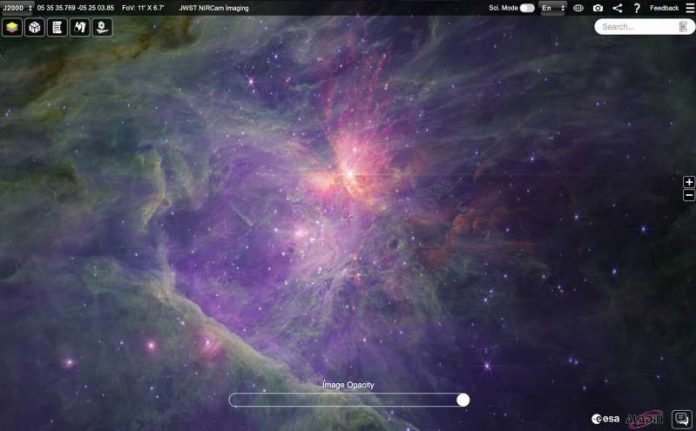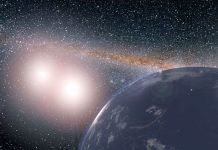
Known as one of the brightest spectacles in the night sky, the Orion Nebula, or Messier 42, has been an object of fascination for astronomers and sky gazers alike.
The fresh images captured by the James Webb Space Telescope (JWST) and now included in ESA’s ESASky application provide a deeper look into this luminous nebula, opening a new window to explore and understand the cosmic ballet of star formation and evolution.
Dazzling Light Show in the Sky: An Overview of the Orion Nebula
Sitting just south of the easily recognizable Orion’s belt, the Orion Nebula is not just a bright, distant cloud in our night sky but also a vibrant hub of astronomical activity.
At the heart of the nebula lies the young and robust Trapezium Cluster of stars. Their massive sizes and powerful ultraviolet radiation fields illuminate the surrounding gas and dust, creating a mesmerizing light show that we perceive as the glowing Orion Nebula.
But behind this vibrant display lies the OMC-1 molecular cloud, a space where protostars – baby stars in the making – are born even today.
The nebula is much more than a beautiful astronomical phenomenon.
It is a bustling stellar nursery, hosting an array of phenomena and objects like outflows and planet-forming disks around young stars, embedded protostars, brown dwarfs (stars that didn’t quite make it), free-floating planetary mass objects, and photodissociation regions, where the intense radiation from the massive stars influences the chemistry of the gas.
Behind the Glow: The Intricate World of Star Formation
The new images from JWST reveal not just the vivid glow of the nebula but also intricate details that provide invaluable insights into the cosmic processes occurring there.
Interestingly, astronomers have observed ‘fingers’ extending from the central star-forming ‘BN-KL’ region, which are expanding rapidly due to an explosive event that occurred 500 to 1,000 years ago.
This colorful display, with red emitting from shocked molecular hydrogen and green tips from ionised iron, isn’t just a cosmic art but tells a tale of dynamic processes and turbulent history within the nebula.
Exploring the Depths of Orion through ESASky
Thanks to the JWST’s near-infrared camera, NIRCam, astronomers and cosmic enthusiasts can now delve deeper into Orion’s world through two mosaics created from the short and long-wavelength channels.
These are some of the largest Webb mosaics observed so far and are a testament to the telescope’s capability to capture high-resolution images over a large area.
The short-wavelength mosaic reveals striking details in disks and outflows, exhibiting the fine structural details of the nebula, while the long-wavelength mosaic showcases a complex network of dust and organic compounds known as polycyclic aromatic hydrocarbons.
These two perspectives allow observers to explore the diverse elements and activities within the Orion Nebula.
The integration of these mosaics into ESA’s ESASky application makes this cosmic exploration accessible not just to astronomers, but to anyone interested in the celestial world.
The user-friendly interface allows users to visualize and download astronomical data, welcoming people to uncover hidden astronomical treasures within the depths of the Orion Nebula.
In providing these new, intricate images of the Orion Nebula, the JWST is not merely capturing stunning astronomical phenomena but also unraveling the nebula’s secrets, offering new opportunities to understand the complex and awe-inspiring processes of star birth and evolution.
Written by Chris Evans, Mark McCaughrean, Sandor Kruk, and Sam Pearson.
Follow us on Twitter for more articles about this topic.



